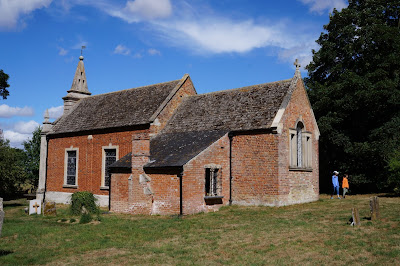Unless you come on pilgrimage "to kneel where prayer has been valid," following the "broken king" Charles I or drawn by the famous lines in T. S. Eliot's poem, there is not much to see or do in Little Gidding beyond inspecting the tiny church, parts of which may go back to the building that was standing when Charles visited in the 1640's (see the links here and here).
I didn't notice a pig-sty, but in other respects T. S. Eliot's description of Little Gidding can't be matched:

If you came this way,
Taking the route you would be likely to take
From the place you would be likely to come from,
...
It would be the same at the end of the journey,
If you came at night like a broken king,
If you came by day not knowing what you came for,
It would be the same, when you leave the rough road
And turn behind the pig-sty to the dull façade
And the tombstone. And what you thought you came for
Is only a shell, a husk of meaning
From which the purpose breaks only when it is fulfilled
If at all. Either you had no purpose
Or the purpose is beyond the end you figured
And is altered in fulfilment. There are other places
Which also are the world's end, ...
But this is the nearest, in place and time,
Now and in England.
If you came this way,
Taking any route, starting from anywhere,
At any time or at any season,
It would always be the same: you would have to put off
Sense and notion. You are not here to verify,
Instruct yourself, or inform curiosity
Or carry report. You are here to kneel
Where prayer has been valid.
- From T. S. Eliot's "Little Gidding"
To be honest, we came to inform curiosity not to kneel, but out of respect for those who were already there when we barged in, I didn't get many pictures of the inside of the church:
The "Four Quartets," of which "Little Gidding" is the final part, has long been one of my favourite poems, and it was neat to be able to pick up a copy and skim through "Little Gidding" on location. Perhaps I will find that "the purpose is beyond the end [I] figured, and is altered in fulfilment."
At any rate, I am also fascinated by the story of the religious community that drew King Charles to Little Gidding in the first place.
The property was purchased in 1625 by Mary Ferrar, the widow of one of the founding members of the Virginia Company, and her son Nicholas. They were joined by her other son John, her daughter Susanna, and their extended families. Nicholas was ordained as a deacon by the future Archbishop Laud in 1626 and soon established a devotional routine based on the Book of Common Prayer that included daily services for the whole family--matins at 6:30 a.m., the litany at 10 a.m. and evensong at 4 p.m.--as well as hourly prayers and a night vigil with readings from the Gospels and Psalms. According to the Little Gidding Church website,
"To instruct the younger members of the extended family in the gospel story and to develop their manual dexterity, Nicholas devised a Harmony of the four gospels. This Harmony provided the narrative for the hourly gospel readings. To create it, individual lines were cut from the four gospel narratives and pasted together on the page to make one continuous text. The pages were also illustrated with engravings, some of which Nicholas may have brought back from his continental travels many years earlier. When King Charles heard of the Harmony’s existence, he sent to borrow it, returning it only when the family agreed to make another for him."I like telling my students this story to show that studying a synopsis of the Gospels--with parallel passages laid side-by-side--can be a devotional practice.
The best information we located about Little Gidding is in the Oxford Dictionary of National Biography entries on Little Gidding, Nicholas Ferrar, and John Ferrar. Less authoritative, but free alternatives may be found here, here and here.
Our next destination, via back roads and rolling hills, was Bedford.






No comments:
Post a Comment